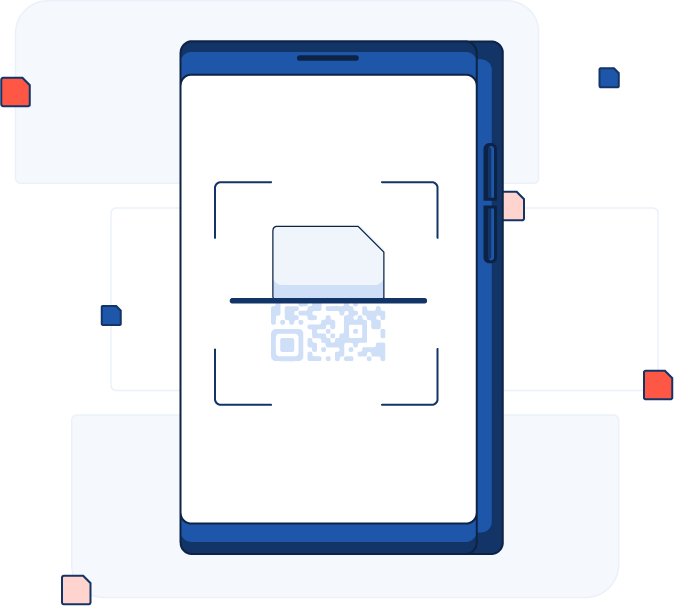eSIM vs SoftSIM: Wat is het verschil?
In 2018 Apple launched its first Iphone with eSIM support and just two years ago they announced that all Iphones for the US market will no longer support physical SIMs and they will move towards Digital SIM cards.
Traditional SIM cards have always been the standard solution for connecting cellular enabled devices and although this will continue to be a perfectly viable solution for most use cases, we see these innovative technologies emerging, offering a completely different approach to IoT connectivity.
In this blog post, we aim to learn more about eSIMS and SoftSIMs, exploring the differences, their benefits and the potential they hold for the future of IoT connectivity.
Along the years, the SIM card has evolved quite a bit, shrinking in size to the point where it doesn’t even exist in a physical state.
1FF (First Form Factor): Mini-SIM
2FF (Second Form Factor): Micro-SIM
3FF (Third Form Factor):Nano-SIM
4FF (Fourth Form Factor): Essentially a Nano-SIM card with its surrounding plastic removed, leaving only the chip.
But that’s not what this article is all about - There are 2 other SIM types that promise to change the future of cellular connectivity and IoT.
What’s an eSIM?
eSIM, also referred to as MFF2 (Miniature Card Form Factor 2) or Embedded-SIM, defers from conventional SIM card, which is a physical piece that is easy removable from the device. Instead, the eSIM is integrated by soldering or embedding it directly onto the device's circuit board. These eSIMs are significantly reduced in size compared to traditional SIM cards, making them ideal for space-constrained devices like smartwatches, wearables, and IoT devices.
What is a SoftSIM?
A Soft SIM, also known as a Virtual SIM or Virtual Subscriber Identity Module (vSIM), is a SIM card that exists purely in software, without any physical hardware component. It is typically implemented using Secure Element (SE) technology within the device's chipset or through a software-based solution. Soft SIMs offer similar functionality to traditional SIM cards, enabling users to access mobile networks and make calls, send messages, and use mobile data.
Similarities between eSIM and SoftSIM:
Even though they are quite different in the way they work, they also have similar characteristics that fuel the confusion between the two:
Remote Provisioning: They both allow for remote provisioning and management of mobile subscriptions although not all SoftSIMs support eUICC technology.
Flexibility: Users can switch between different network carriers without the need to physically swap SIM cards.
Space Efficiency: Both technologies save physical space, making them suitable for compact devices.
Potential for Over-the-air Management: They offer the potential for over-the-air management, allowing for easy activation, network switching, and subscription management without requiring physical intervention.
What are the differences between eSIM and SoftSIM:
Implementation: eSIM is embedded directly onto the device's circuit board, while Soft SIM exists purely in software form residing on the device’s processor or on the cellular module itself.
Device Support: eSIM requires device manufacturers to implement hardware support, while Soft SIM can be implemented in software on compatible devices.
Adoption: eSIM has seen broader adoption in various devices, while Soft SIM adoption is still emerging.
Cost reduction potential: The adoption of SoftSIMs, which require no physical components for purchase or installation, has the potential to lower manufacturing costs and shorten production timelines.
Security: eSIM typically relies on hardware-based security features, whereas Soft SIM may raise concerns regarding software-based authentication security.
Industry Standards: eSIM adheres to industry standards and specifications, whereas Soft SIM solutions may vary depending on the provider and implementation.
Traditional SIM cards remain the preferred choice for most applications, yet with advancing technology and the footprint of the devices becoming smaller and smaller, both eSIMs and SoftSIMs promise to become the ideal option for the IoT projects of the future. At Simbase, we are dedicated to delivering outstanding solutions for your projects. Whether you prefer a conventional approach with physical Multi-IMSI or eUICC cards, or seek to pioneer with embedded SIM cards leveraging eUICC technology or SoftSIMs for Smartphones and Tablets, our team is here to assist you. Reach out to one of our IoT experts today to learn more.

